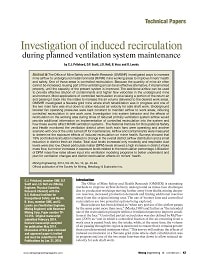Mining Publication: Investigation of induced recirculation during planned ventilation system maintenance
Original creation date: October 2014
Authors: C Pritchard, DF Scott, JD Noll, B Voss, D Leonis
The Office of Mine Safety and Health Research (OMSHR) investigated ways to increase mine airflow to underground metal/nonmetal (M/NM) mine working areas to improve miners’ health and safety. One of those areas is controlled recirculation. Because the quantity of mine air often cannot be increased, reusing part of the ventilating air can be an effective alternative, if implemented properly, until the capacity of the present system is improved. The additional airflow can be used to provide effective dilution of contaminants and higher flow velocities in the underground mine environment. Most applications of controlled recirculation involve taking a portion of the return air and passing it back into the intake to increase the air volume delivered to the desired work areas. OMSHR investigated a Nevada gold mine where shaft rehabilitation was in progress and one of the two main fans was shut down to allow reduced air velocity for safe shaft work. Underground booster fan operating pressures were kept constant to maintain airflow to work areas, inducing controlled recirculation in one work zone. Investigation into system behavior and the effects of recirculation on the working area during times of reduced primary ventilation system airflow would provide additional information on implementation of controlled recirculation into the system and how these events affect M/NM ventilation systems. The National Institute for Occupational Safety and Health monitored the ventilation district when both main fans were operating and another scenario with one of the units turned off for maintenance. Airflow and contaminants were measured to determine the exposure effects of induced recirculation on miner health. Surveys showed that 19% controlled recirculation created no change in the overall district airflow distribution and a small reduction in district fresh air intake. Total dust levels increased only modestly and respirable dust levels were also low. Diesel particulate matter (DPM) levels showed a high increase in district intake mass flow, but minor increases in exposure levels related to the recirculation percentage. Utilization of DPM mass flow rates allows input into ventilation modeling programs to better understand and plan for ventilation changes and district recirculation effects on miners’ health.

- Case Study of Controlled Recirculation at a Wyoming Trona Mine
- Degasification System Selection for U.S. Longwall Mines Using an Expert Classification System
- Experimental and Modeling Investigation of the Effect of Ventilation on Smoke Rollback in a Mine Entry
- In-depth Survey Report: Control Technology for Environmental Enclosures - The Effect of Wind Speed Upon Aerosol Penetration Into an Enclosure at Clean Air Filter, Defiance, IA
- Laboratory Testing To Quantify Dust Entrainment During Shield Advance
- Measurement of Airflow in a Simulated Underground Mine Environment Using an Ultrasonic Anemometer
- Sonic Anemometer Airflow Monitoring Technique for Use in Underground Mines
- Technology News 518 - Super Stopping: A Permanent Solid Stopping for Directing Ventilation Airflows in Large-opening Metal/Nonmetal Mines
- Testing and Evaluation of an Inflatable Temporary Ventilation Control Device
- Tracer Gas as an Aid in Mine Ventilation Analysis